Discover 35 hidden attractions, cool sights, and unusual things to do in Jersey City (United States). Don't miss out on these must-see attractions: Statue of Liberty Museum, Liberty State Park, and Empty Sky Memorial. Also, be sure to include Colgate Clock in your itinerary.
Below, you can find the list of the most amazing places you should visit in Jersey City (New Jersey).
Table of Contents
Statue of Liberty Museum
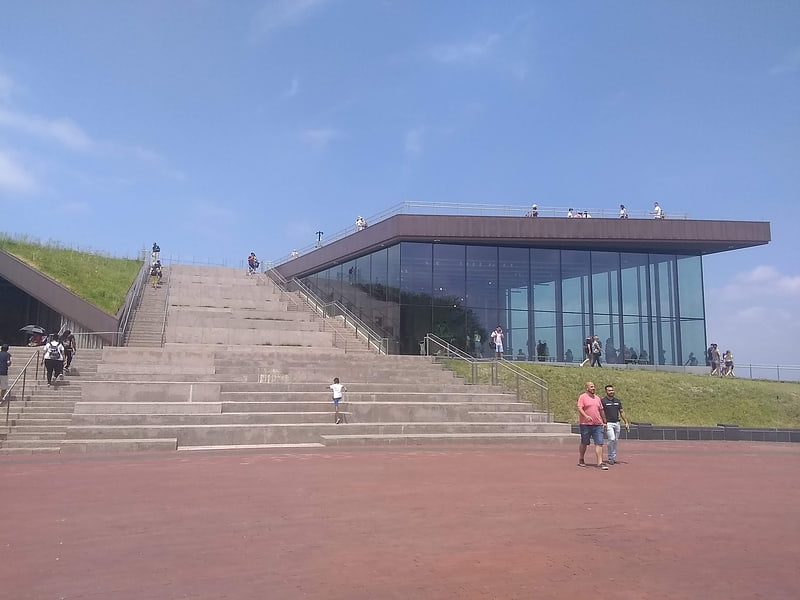
The Statue of Liberty Museum is located on Liberty Island in New York City. The museum opened on May 16, 2019, and is focused on the creation, meaning, and history of the Statue of Liberty, a large statue by Frédéric Auguste Bartholdi which the people of France gave to the people of the United States in 1886.[1]
Liberty State Park
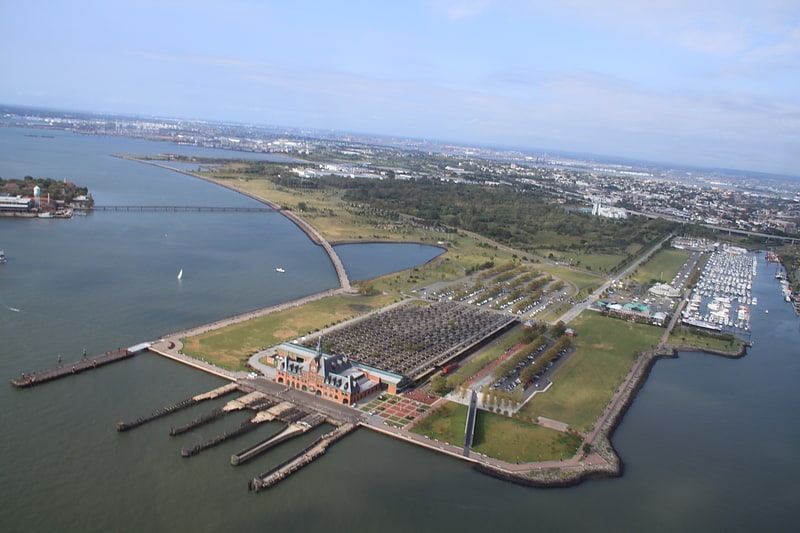
Park in Jersey City, New Jersey. Liberty State Park is a park in the U.S. state of New Jersey, located on Upper New York Bay in Jersey City, opposite both Liberty Island and Ellis Island. The park opened in 1976 to coincide with bicentennial celebrations and is operated and maintained by the New Jersey Division of Parks and Forestry. Liberty State Park covers 1,212 acres. The main part of the park is bordered by water on three sides: on the north by the Morris Canal Big Basin and on the south and east by Upper New York Bay. The New Jersey Turnpike Newark Bay Extension marks its western perimeter.[2]
Empty Sky Memorial

Monument in Jersey City, New Jersey. Empty Sky is the official New Jersey September 11 memorial to the state's victims of the September 11 attacks on the United States. It is located in Liberty State Park in Jersey City at the mouth of Hudson River across from the World Trade Center site. Designed by Jessica Jamroz and Frederic Schwartz, it was dedicated on Saturday, September 10, 2011, a day before the tenth anniversary of the attacks.[3]
Address: Audrey Zapp Dr, 07305 Jersey City
Colgate Clock

Historical landmark in Jersey City, New Jersey. The Colgate Clock is an octagonal clock facing the Hudson River near Exchange Place in Jersey City, New Jersey. It has a diameter of 50 feet. It is currently situated 1,300 feet south of where the headquarters of consumer products conglomerate Colgate-Palmolive used to be sited, before it left the area in 1985.[4]
Address: 2 Essex Street, Jersey City
Liberation
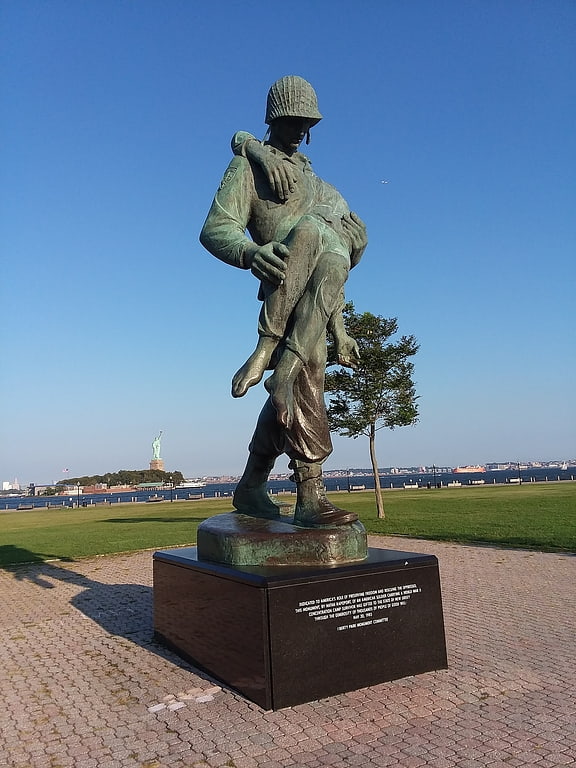
Monument in Jersey City, New Jersey. Liberation is a bronze Holocaust memorial created by the sculptor Nathan Rapoport, located in Liberty State Park in Jersey City, in Hudson County, New Jersey, United States. Officially dedicated on May 30, 1985, the monument portrays an American soldier, carrying the body of a Holocaust survivor out of a Nazi concentration camp.[5]
Address: Liberty State Park, Jersey City
Liberty Science Center
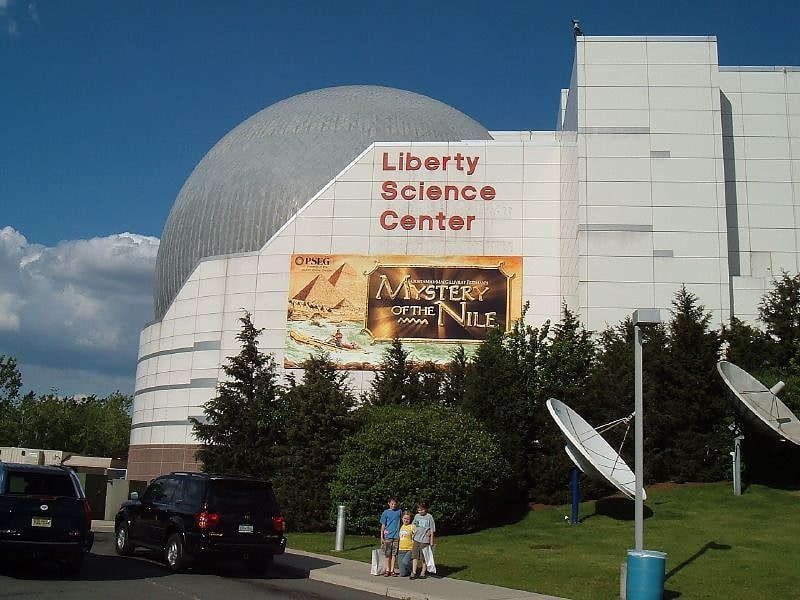
Museum in Jersey City, New Jersey. Liberty Science Center is an interactive science museum and learning center located in Liberty State Park in Jersey City, New Jersey, United States. At its opening it was the largest such planetarium in the Western Hemisphere and the world's fourth largest.
The center, which first opened in 1993 as New Jersey's first major state science museum, has science exhibits, numerous educational resources, and the original Hoberman sphere, a silver, computer-driven engineering artwork designed by Chuck Hoberman.[6]
Address: 222 Jersey City Blvd, 07305-4636 Jersey City
Katyń Memorial
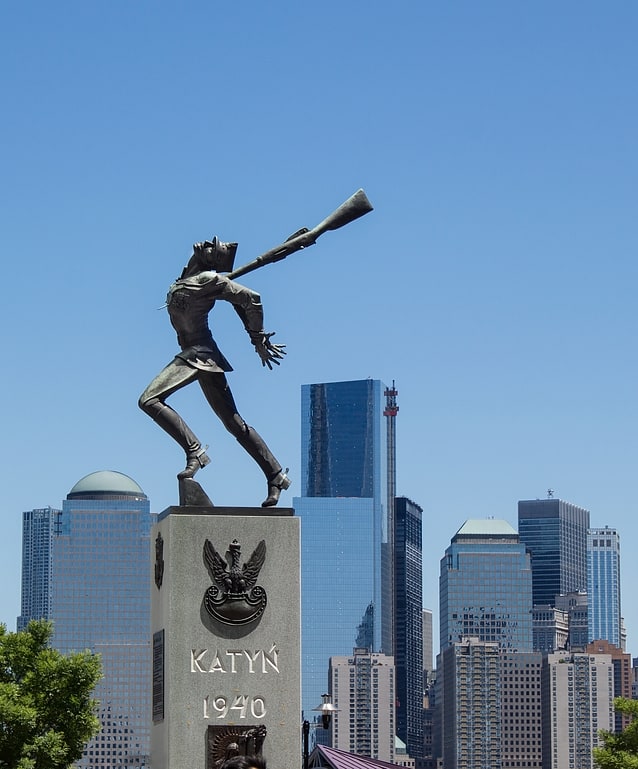
Statue by Andrzej Pitynski. The Katyń Memorial is a bronze statue created by Polish-American sculptor Andrzej Pitynski in dedication to the victims of the 1940 Katyn massacre, in which thousands of Polish Army officers and intellectual leaders who had been interned at Kozielsk or imprisoned at Ostashkov and Starobielsk had been killed by the occupying Soviet People's Commissariat for Internal Affairs, or NKVD. The memorial stands at Exchange Place in Jersey City, New Jersey, United States, near the mouth of the Hudson River. Unveiled in June 1991, the statue depicts a bound and gagged Polish soldier with a bayoneted rifle impaled through his back. The statue stands 34-foot-tall and is atop a granite base containing Katyn soil. Its base also depicts a Polish woman carrying her starving child in memorial to the Polish citizens deported to Siberia that began shortly before the massacre.[7]
Stanley Theater
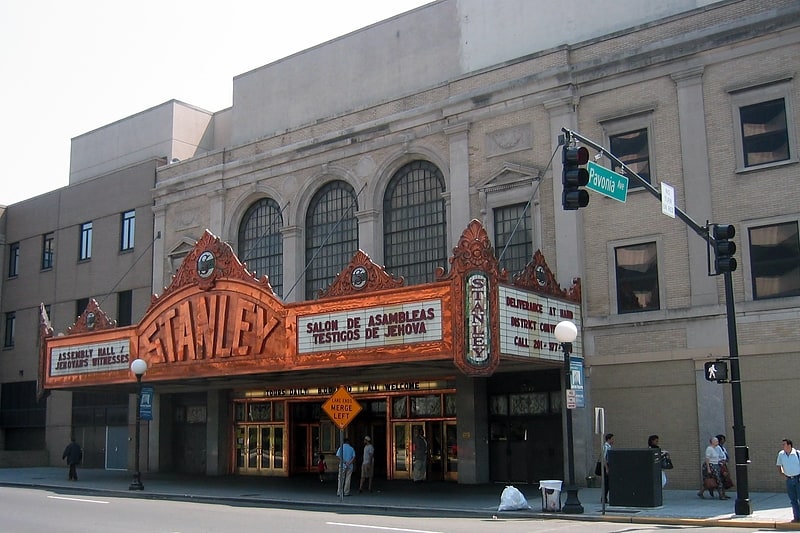
Theater in Jersey City, New Jersey. The Stanley Theater at Kennedy Boulevard and Pavonia Avenue is near Journal Square in Jersey City, New Jersey.
The theater opened to the public on March 24, 1928. Mayor Frank Hague attended the ceremonies that evening and, with the audience, was greeted on the screen by actress Norma Talmadge. An orchestral performance, a stage show called "Sky Blues," a newsreel, and a musical piece on the Wurlitzer organ, preceded the showing of The Dove starring Talmadge and Gilbert Roland.
The Stanley was designed by architect Fred Wesley Wentworth (1864-1943), who is noted for designing many buildings in Paterson following the 1902 fire. When it opened, its 4,300 seats earned it the rank of the second largest theater on the East Coast, behind only New York City's Radio City Music Hall. It was fourth in the country in number of seats in a one-screen theater, behind Radio City, and the Detroit and St. Louis Fox theaters. It was an elegant and popular venue into the 1960s. Stage shows at the theater reflected the popular culture of the times with entertainers ranging from The Three Stooges and Jimmy Durante to Tony Bennett, Janis Joplin, Dolly Parton, and the Grateful Dead. During the 1970s, however, movie attendance suffered and the theater fell into disrepair, and became an RKO (Radio-Keith-Orpheum Pictures) grindhouse. The once beautiful metalwork throughout the building was painted dark blue, and the Wurlitzer organ was removed in the 1970s. It finally closed as a movie theater April 20, 1978.
In 1983, the building was purchased by the Watch Tower Society for use as a convention and assembly hall for Jehovah's Witnesses. Thousands of Witness volunteers worked over a nine-month period to renovate the theater. Beginning in October 2012, the theater underwent further renovation by over 2,000 Witness volunteers from across the United States.[8]
Address: Jersey City, 2932 John F. Kennedy Blvd
Hoboken Historical Museum

Museum in Hoboken, New Jersey. The Hoboken Historical Museum, founded in 1986, is located in Hoboken, New Jersey and presents rotating exhibitions and activities related to the history, diverse culture, architecture and historic landmarks of the city. In 2001, the museum moved to 1301 Hudson Street into the last standing building of former Bethlehem Steel Hoboken Shipyard. Through its Hoboken Oral History Project, the museum and the Friends of the Hoboken Public Library have been capturing the recollections of longtime residents: stories about mom-and-pop shops, the city's many movie palaces, jazz clubs, vaudeville performances, political campaigns, ethnic traditions, and factory jobs.[9]
Address: 1301 Hudson St, 07030 Hoboken (Hoboken)
Loew's Jersey Theatre
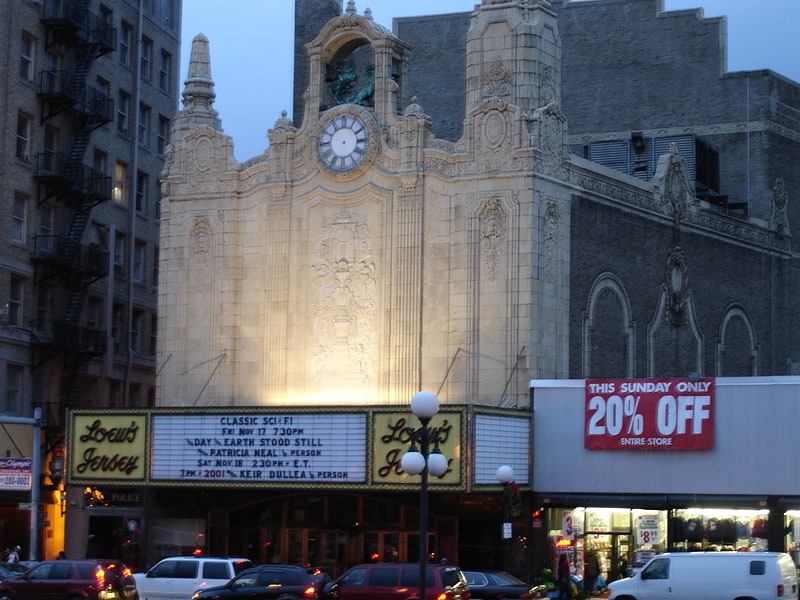
Movie theater in Jersey City, New Jersey. The Loew's Jersey Theatre is a movie palace type theater and live entertainment venue located in Jersey City, New Jersey. Opened in 1929, it was one of the five Loew's Wonder Theatres, a series of flagship Loew's movie palaces in the New York City area. It was designed by the architectural firm of Rapp and Rapp in a Baroque/Rococo style. Tri-plexed in 1974, and then closed in 1986, it was dark for years. It was purchased by the city in 1993 and been operated by a volunteer organisation, the Friends of the Loews, since that time. The theater was designated as a New Jersey Registered Historic Site in 2009. In a move opposed by Friends of the Loews, the city in June 2014, agreed to let AEG Live operate the venue. After going to court, the lease by Friends of the Loews remains in effect. In February 2021 it was announced that the theater would undergo an $72million restoration. expected to begin in 2022.[10]
Address: Jersey City, 54 Journal Square
Museum of Russian Art
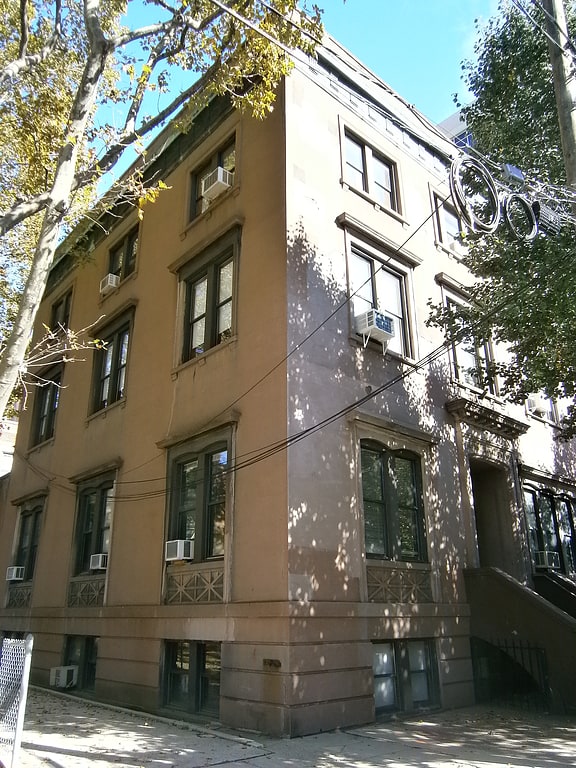
Museum in Jersey City, New Jersey. The Museum of Russian Art is a museum in Jersey City, New Jersey dedicated to exhibiting Russian art, particularly Soviet Nonconformist Art. It was established in 1980 as CASE Museum of Contemporary Russian Art The museum's historic brownstone building in Paulus Hook underwent renovation and re-opened in 2010.
The museum's mission statement as written in its request for proposals reads:
The Museum of Russian Art in Jersey City (MORA) is dedicated to being a preeminent cultural institution in its field, a major full-service art museum focusing upon the collection, preservation, documentation and exhibition of challenging and important artworks.
MORA is a space devoted to developing cultural exchange between different national diasporas in the US, and between the US and other countries. Emerging and established artists, both local and international, come together in both small and large scale exhibitions that center on the practice and creation of socially significant and innovative art. MORA is specifically interested in cultural programs of unity between nations, along with academic discourse and debate and how these are expressed and promoted by art and culture in general. MORA focuses on projects that show the cultural exchange, collaboration, and dialogue between different communities in the lives of artists-immigrants of any national descent, and within a greater pluralistic American community and nation, and any nation on the way towards establishing universal human values of culture in the cooperative world community.
The Museum's special focus is upon Russian art and culture, especially art and culture of the twentieth and twenty-first centuries, from the colossal achievements of the great Russian Avant-Garde (Kandinsky, Malevich and others) through the fascinating era of Nonconformist (or Unofficial) Art of the period between the late 1950s and the 1980s and up to the most recent developments in contemporary living artistic and cultural life. Russian art is broadly construed, including all art that can be associated with Russian culture – art belonging to the cultural life of Russia; art produced by Russians, Russian-speakers, and artists of Russian extraction, back- ground or heritage; art that is itself concerned with Russian language, history and culture – all this is within MoRA's purview.[11]
Mana Contemporary

Art center in Jersey City, New Jersey. Mana Contemporary is a cultural center in Jersey City, New Jersey, United States with affiliated centers in Chicago and Miami.[12]
Address: 888 Newark Ave, 07306 Jersey City
Snake Hill
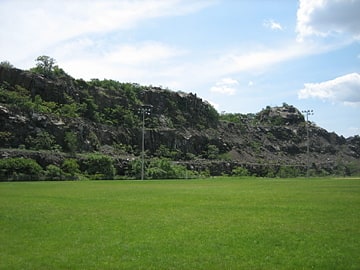
Snake Hill is an igneous rock intrusion jutting up from the floor of the Meadowlands in southern Secaucus, New Jersey, at a bend in the Hackensack River. It was largely obliterated in the 1960s by quarrying that reduced the height of some sections by one-quarter and the area of its base by four fifths. The diabase rock was used as building material in growing areas like Jersey City. The remnant of the hill is the defining feature of Laurel Hill County Park. The high point, a 203-foot graffiti-covered inselberg rock formation, is a familiar landmark to travelers on the New Jersey Turnpike's Eastern Spur, which skirts the hill's southern edge. The crest of the hill's unusual, sloping ridge is about 150 feet high.[13]
Temple Beth-El
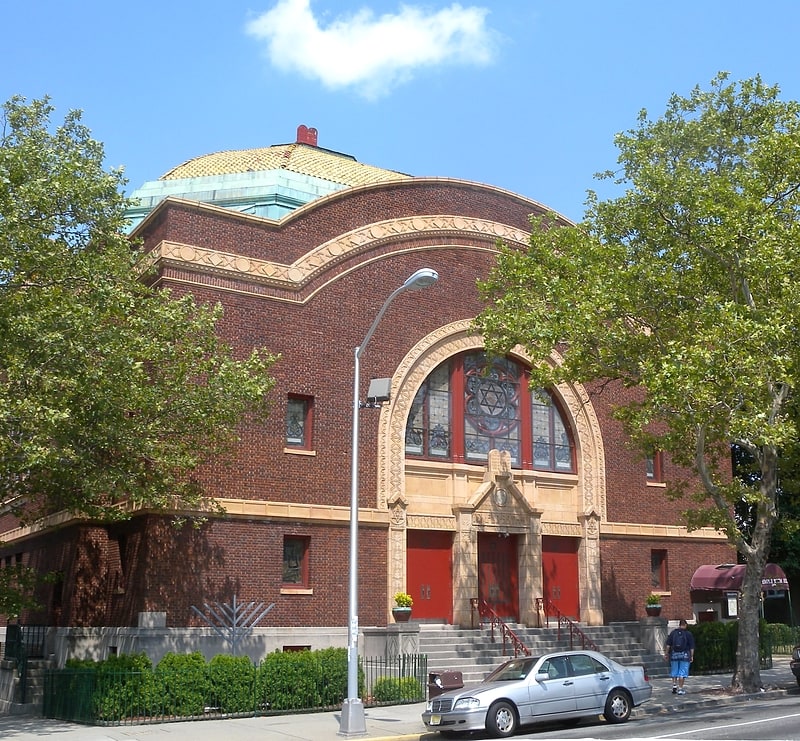
Reform synagogue in Jersey City, New Jersey. Temple Beth-El is a Reform synagogue in Jersey City, New Jersey. located at 2419 Kennedy Boulevard in the Bergen Section.[14]
Address: 2419 John Fitzgerald Kennedy Blvd, 07304-1997 Jersey City
Grace Church Van Vorst
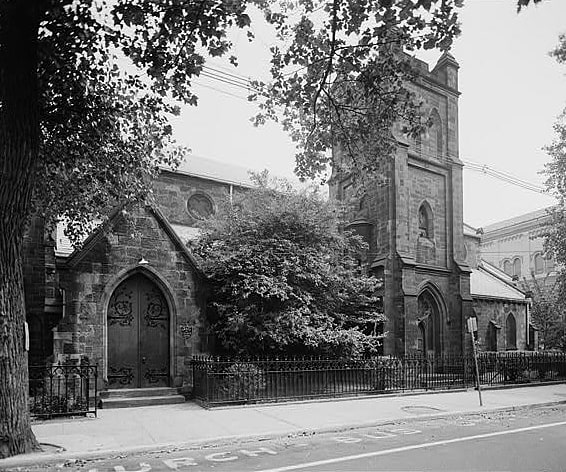
Church in Jersey City, New Jersey. The Grace Church Van Vorst, is located in Jersey City, Hudson County, New Jersey, United States. The church was added to the National Register of Historic Places on August 1, 1979. The church was built in 1853 and was named after the former Van Vorst Township. The church is an English Gothic-style Episcopal church which was designed by Detlef Lienau. The building is constructed with brownstone and has a slate roof. The church was expanded in 1864 with the addition of two bays to the west and a baptistry added midway on the south side of the building. The 57-foot high square tower was added in 1912. Adjacent to the church is a rectory that was also designed by Lienau in a similar style to the church.[15]
Address: 39 Erie St, 07302-2821 Jersey City
Hoboken City Hall
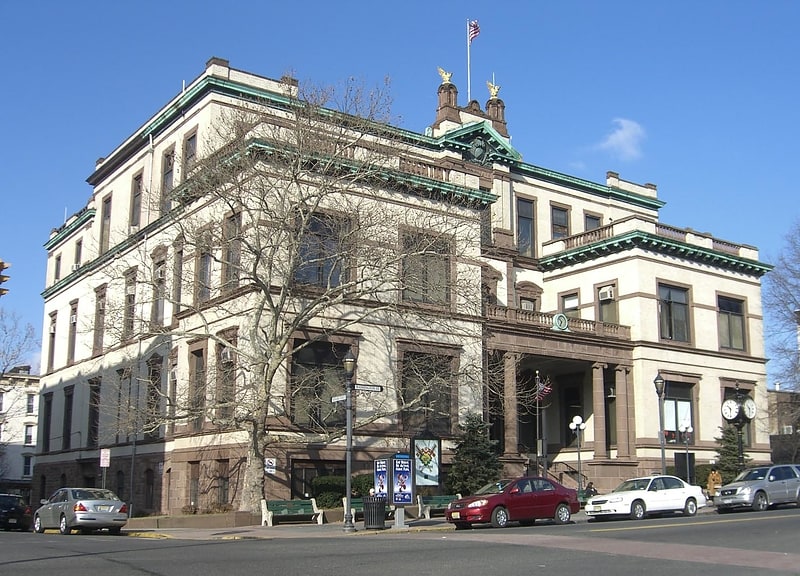
Building. Hoboken City Hall, is located in Hoboken, Hudson County, New Jersey, United States. The building was designed by Francis G. Himpler and was built in 1883. The building was added to the National Register of Historic Places on January 1, 1976. The building is a Second Empire structure modified to a Beaux Art Classicism design.[16]
Address: 94 Washington Street, Jersey City (Hoboken)
Dixon Mills

Museum in Jersey City, New Jersey. Dixon Mills is a residential complex in Jersey City, New Jersey that uses the buildings of the former location of the Joseph Dixon Crucible Company, which was in use between 1847 and 1895. There is a small museum with artifacts from the building and its history in the lobby of the complex.[17]
Hudson Waterfront
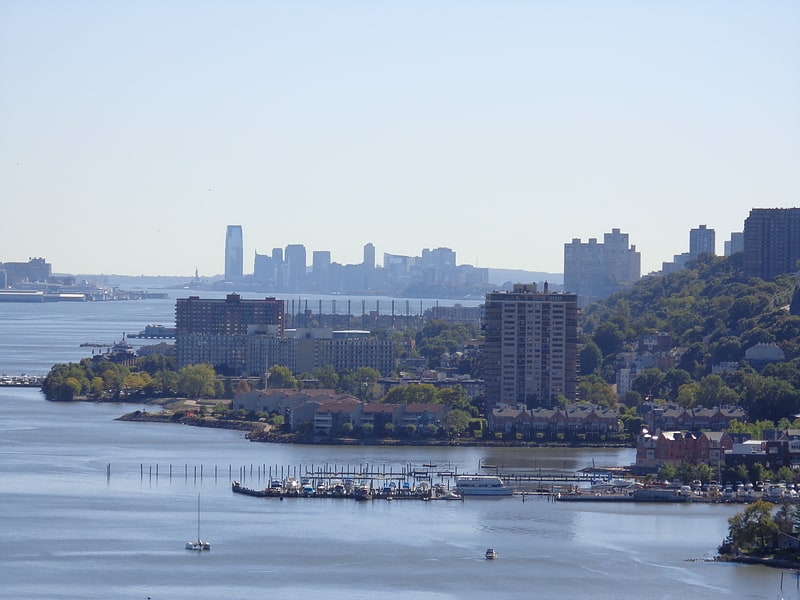
Municipality in New Jersey. The Hudson Waterfront is an urban area of northeastern New Jersey along the lower reaches of the Hudson River, the Upper New York Bay and the Kill van Kull. Though the term can specifically mean the shoreline, it is often used to mean the contiguous urban area between the Bayonne Bridge and the George Washington Bridge that is approximately 19 miles long. Historically, the region has been known as Bergen Neck, the lower peninsula, and Bergen Hill, lower Hudson Palisades. It has sometimes been called the Gold Coast.
The municipalities comprising the Hudson Waterfront are Bayonne, Jersey City, Hoboken, Union City, Weehawken, West New York, Guttenberg and North Bergen in Hudson County and Fairview, Cliffside Park, Edgewater and Fort Lee in Bergen County. To the east, lies the New York City boroughs of Manhattan and Brooklyn, to the south Staten Island, to the west Newark Bay and the New Jersey Meadowlands, and to the north the Northern Valley & Palisades Interstate Park. The Hudson River Waterfront Walkway, which includes sections of the East Coast Greenway, travels along the Hudson River.
During the Dutch colonial era, the area was under the jurisdiction of New Amsterdam and known as Bergen. Jersey City and Hoboken in Hudson County are sometimes referred to as the sixth borough, given their proximity and connections by PATH trains. Fort Lee, in Bergen County, opposite Upper Manhattan and connected by the George Washington Bridge, has also been called the sixth borough.[18]
Harsimus Stem Embankment
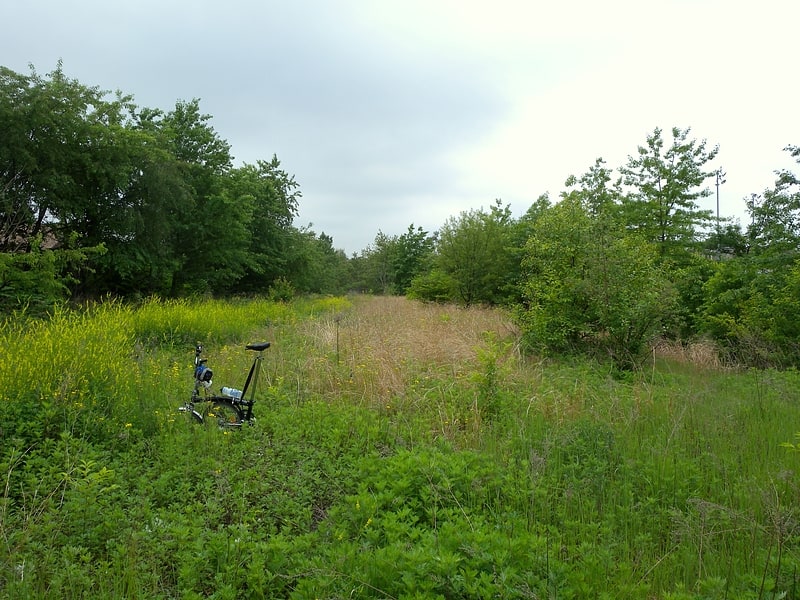
The Harsimus Stem Embankment, also called Sixth Street Embankment, is a half-mile-long historic railroad embankment, now abandoned and largely overgrown with foliage, in the heart of the historic downtown of Jersey City, New Jersey in the United States. The 27-foot-high embankment runs along the south side of Sixth Street west from Marin Boulevard to Brunswick Street. It is the border between the Harsimus and Hamilton Park neighborhoods. The overhead tracks of the beam bridge west of Brunswick Street were dismantled but the stone abutments remain.
This elevated stone structure once carried seven tracks of the Pennsylvania Railroad's Passaic and Harsimus Line to its freight yards and carfloat operations on the Hudson River at Harsimus Cove, and to its warehouse and distribution facility (now Harborside Financial Center). The line was part of the railroad's holdings on the waterfront, which included the Exchange Place passenger terminal and the Greenville Yard. The Embankment is listed on the New Jersey Register of Historic Places, is eligible for the National Register, and is a Jersey City municipal landmark.
In 2010, a local citizens' movement lobbied local governments, chiefly Hudson County and the city of Jersey City, to acquire the land and convert the embankment to a public park. The developer who owns the land where the embankment is located is opposed. In September 2010 a federal court ruled that sale to the developer was legal and that the city has previously not exercised its first option to buy the right-of-way from Conrail. The decision meant the city could claim the structure through eminent domain. A $1 million grant request was not honored. The developer's proposals to sell portions of the land to the city were rejected in 2011. The case was brought to an appeals court, which found that the case against the developer could proceed. In January 2012 it was announced that a deal had been arranged whereby the city would purchase the property for $7 million. In September 2012 it was ruled that Conrail had not gone through the required process of "abandonment" and was not legally able to sell the property. Again in 2020, a deal was announced.[19]
Address: Sixth St., 07302 Jersey City
Journal Square
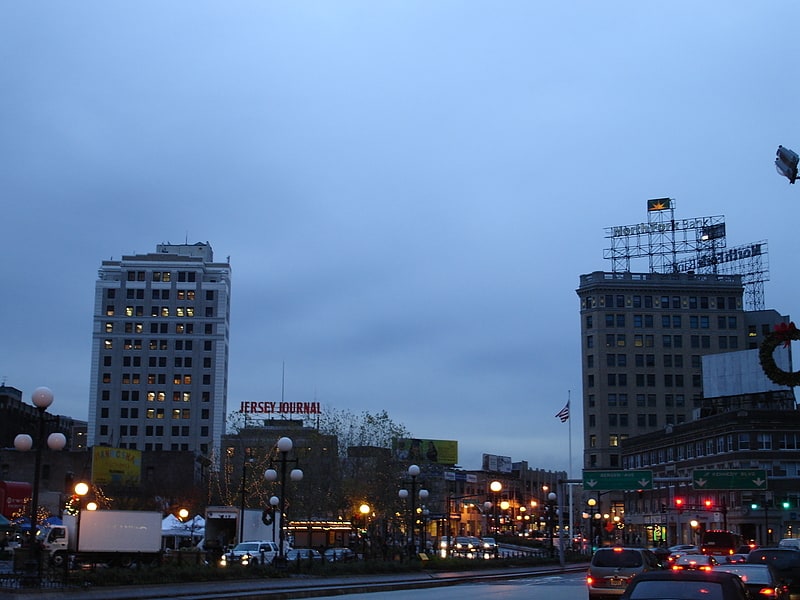
Residential district in Jersey City, New Jersey. Journal Square is a business district, residential area, and transportation hub in Jersey City, New Jersey, which takes its name from the newspaper Jersey Journal whose headquarters were located there from 1911 to 2013. The "square" itself is at the intersection of Kennedy Boulevard and Bergen Avenue. The broader area extends to and includes Bergen Square, McGinley Square, India Square, the Five Corners and parts of the Marion Section. Many local, state, and federal agencies serving Hudson County maintain offices in the district.[20]
Van Vorst Park
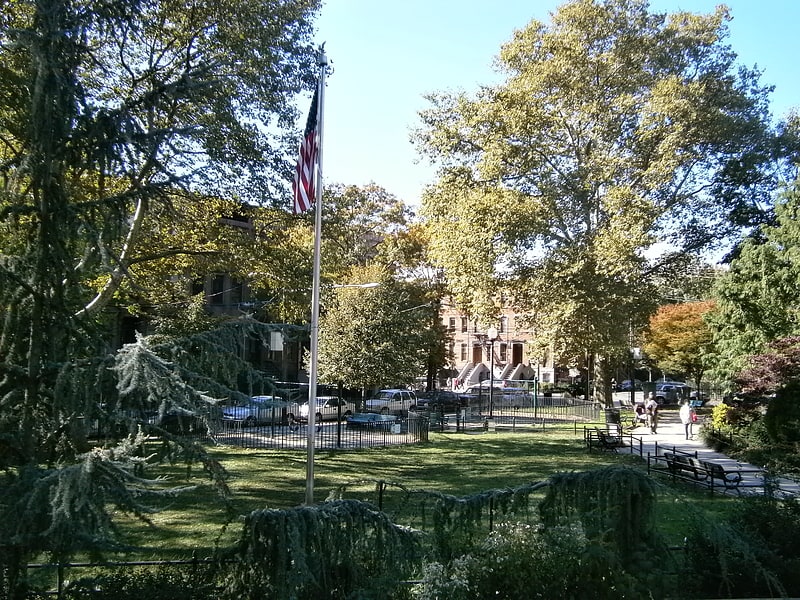
Park in Jersey City, New Jersey. Van Vorst Park is a neighborhood in the Historic Downtown of Jersey City, Hudson County, New Jersey, United States, centered on a park sharing the same name. The neighborhood is located west of Paulus Hook and Marin Boulevard, north of Grand Street, east of the Turnpike Extension, and south of The Village and Christopher Columbus Drive. Much of it is included in the Van Vorst Park Historical District.
The park was a centerpiece of Van Vorst Township, a township that existed in Hudson County from 1841 to 1851. Van Vorst was incorporated as a township by an Act of the New Jersey Legislature on April 12, 1841, from portions of Bergen Township. On March 18, 1851, Van Vorst Township was annexed by Jersey City.
The name Van Vorst comes from a prominent family in the area, the first of which arrived in the 1630s as superindentent of the patroonship Pavonia, the earliest European settlement on the west bank of the Hudson River in the province of New Netherland. His homestead at Harsimus, plus others at Communipaw, Paulus Hook, Minakwa, Pamrapo were later incorporated into Bergen. His namesake and eighth generation descendant, Cornelius Van Vorst, was the twelfth Mayor of Jersey City serving from 1860 to 1862.
Like Harsimus Cove and Hamilton Park to the north and Bergen-Lafayette to the southwest, the neighborhood contains nineteenth century rowhouses and brownstones. It is home to the Jersey City Medical Center, James J. Ferris High School (named for the Jersey City citizen who laid the foundation of the Hudson and Manhattan Railroad Powerhouse with his firm Stillman, Delehanty and Ferris), and Old Colony Shopping Plaza. Landmarks include Barrow Mansion and Dixon Mills.
The Grove Street PATH station is located nearby to the north and is the Jersey Avenue (HBLR station) to the south.[21]
Lincoln Park

Park in Jersey City, New Jersey. Lincoln Park is an urban park in Jersey City, New Jersey with an area of 273.4 acres. Part of the Hudson County Park System, it opened in 1905 and was originally known as West Side Park. The park was designed by Daniel W. Langton and Charles N. Lowrie, both founding members of the American Society of Landscape Architects.
The park consists of two distinct sections: Lincoln Park East, 150.4 acres (60.9 ha), and Lincoln Park West, 123 acres (50 ha). The sections are named for their positions relative to U.S. Route 1/9 Truck, which passes between them, and are connected by foot and vehicular bridges over the highway. The Lincoln Park Nature Walk is part of wetlands restoration project adjacent to the Hackensack River. The Hackensack RiverWalk is a partially completed greenway along the banks of the river running the length of the Hudson County shoreline. The East Coast Greenway also traverses the park.[22]
Wittpenn Bridge
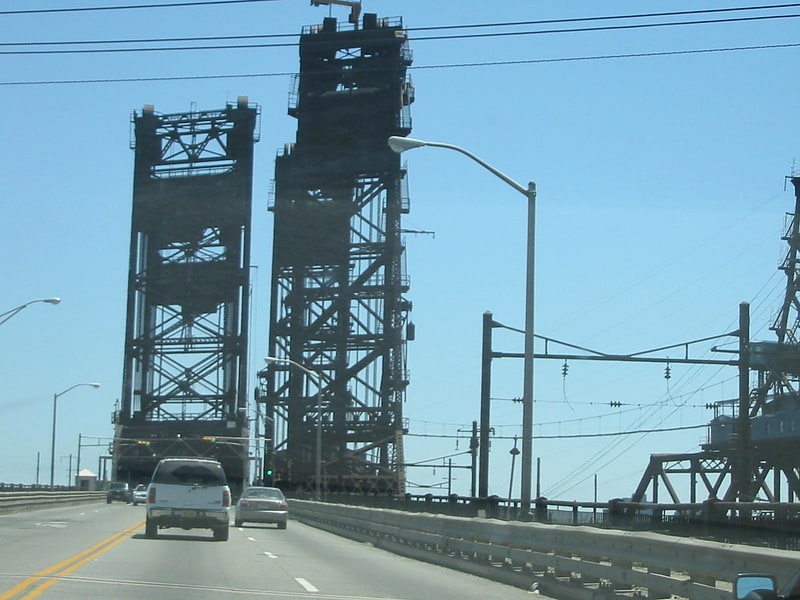
Vertical-lift bridge in Hudson County, New Jersey. The Wittpenn Bridge is a vertical-lift bridge that carries New Jersey Route 7 over the Hackensack River connecting Kearny and Jersey City, New Jersey. It is named after H. Otto Wittpenn, a former mayor of Jersey City. The bridge has an annual average daily traffic of nearly 50,000 vehicles, including about 2,000 trucks. In 2005, the bridge was raised to accommodate 80 boats passing underneath. The original span opened in 1930; a replacement opened in 2021.[23]
Hoboken
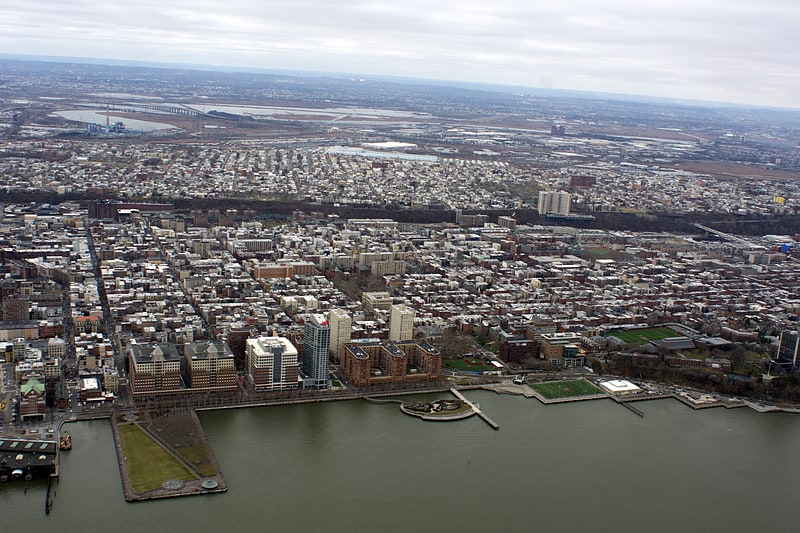
City in New Jersey. Hoboken is a city in Hudson County, New Jersey, United States. As of the 2020 United States Census, the city's population was 60,417. Among cities with a population above 50,000, Hoboken was ranked as the third-most densely populated municipalities in the United States, with more than 42,400 people per square mile. Hoboken is part of the New York metropolitan area and is the site of Hoboken Terminal, a major transportation hub for the tri-state region.
Hoboken was first settled as part of the Pavonia, New Netherland colony in the 17th century. During the early 19th century, the city was developed by Colonel John Stevens, first as a resort and later as a residential neighborhood. Originally part of Bergen Township and later North Bergen Township, it became a separate township in 1849 and was incorporated as a city in 1855. Hoboken is the location of the first recorded game of baseball and of the Stevens Institute of Technology, one of the oldest technological universities in the United States. It is also known as the birthplace and hometown of Frank Sinatra; various streets and parks in the city have been named after him.
Located on the Hudson Waterfront, the city was an integral part of the Port of New York and New Jersey and was home to major industries for most of the 20th century. The character of the city has changed from an artsy industrial vibe from the days when Maxwell House coffee, Lipton tea, Hostess Cupcakes, and Wonder Bread called Hoboken home, to one of trendy shops and expensive condominiums. It has been ranked 2nd in Niche's "2019 Best Places to Live in Hudson County" list.[24]
Jersey City and Harsimus Cemetery
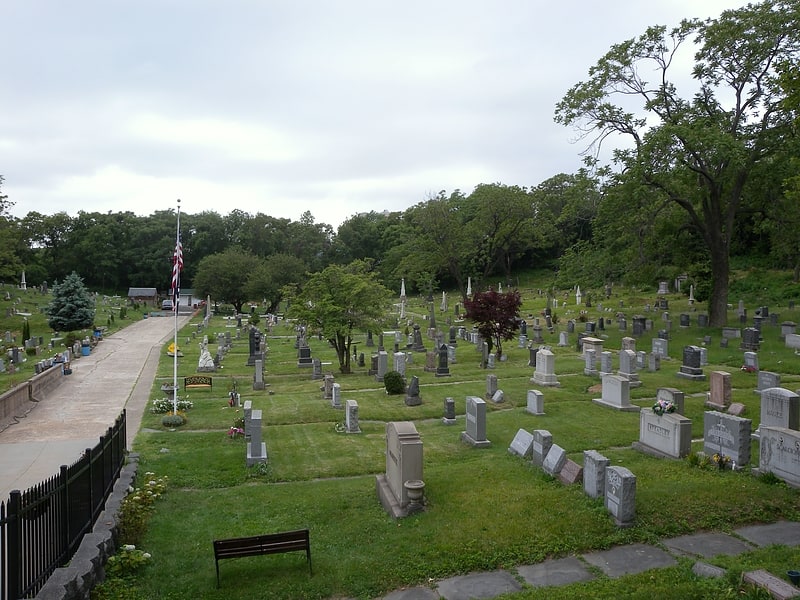
Cemetery in Jersey City, New Jersey. Jersey City and Harsimus Cemetery is a historic rural cemetery located in Jersey City, New Jersey. It was established in 1829 by the first cemetery company founded in the State of New Jersey and is the size of 6 acres. The cemetery is an early example of Garden Style landscape cemeteries. The cemetery fell into disrepair and was abandoned in 2008. A volunteer group has since been founded to maintain the cemetery.
The location of the cemetery was used as an ammunition bunker for the War of 1812 and was a site of skirmishes in 1780 during the Revolutionary War.
Since 2011 goats are used for weed control during the summer.[25]
Address: 435 Newark Ave, 07302-1825 Jersey City
Hudson County Burial Grounds

Potter's field. The Hudson County Burial Grounds are also known as the Secaucus Potter's Field and Snake Hill Cemetery and it is located in Secaucus, New Jersey.
The cemetery was cleared of bodies to make room for the Secaucus Transfer Station and Exit 15X of the New Jersey Turnpike between 1992-2003. More than 4,000 bodies were disinterred. A few were identified and reburied by their families, but the rest were reinterred in a Hackensack cemetery. (The bodies were to be interred at Hoboken Cemetery, North Bergen, but when pits were dug for the bodies, human remains were found, in what was sold as virgin cemetery space.)
It is estimated that there are another 5,000 or so graves that have not been found, probably lying outside the Secaucus Junction projects construction areas. Some may lie underneath footings and embankments of the New Jersey Turnpike.
The bodies were reburied at the Maple Grove Park Cemetery in Hackensack, New Jersey. The last body was removed from the cemetery on October 31, 2003. The remains of 4,572 were transferred. The Register of Burials listed interments between December 31, 1880, and April 12, 1962, but those within the removal area were from between 1920 and 1962. The cemetery served the insane asylum and the poor house that later became the Meadowview Psychiatric Hospital.[26]
Hoboken Public Library
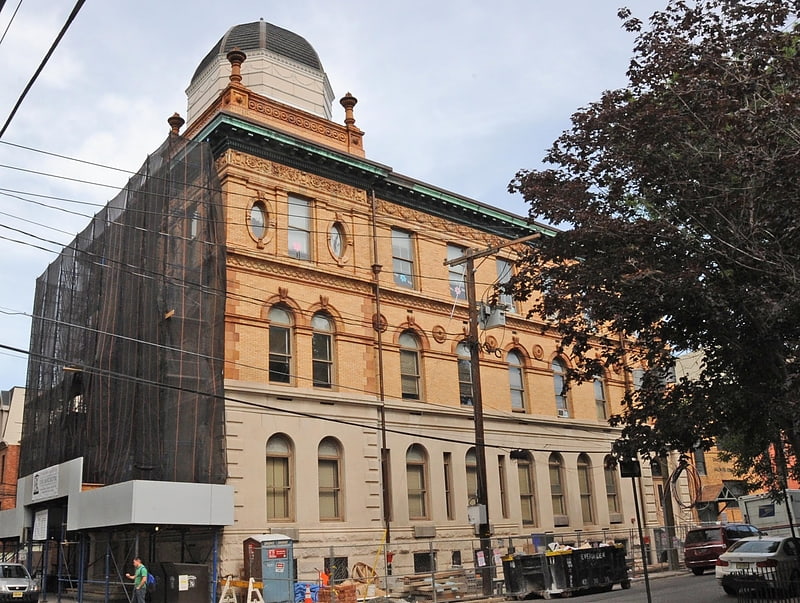
Public library in Hoboken, New Jersey. The Hoboken Public Library is the free public library of Hoboken, New Jersey. It is a member of the Bergen County Cooperative Library System, a consortium of municipal libraries in the northeastern New Jersey counties of Bergen, Hudson, Passaic, and Essex. The library was established through the philanthropy of Martha Bayard Stevens. The building opened in 1897. It is listed on the New Jersey Register of Historic Places and the National Register of Historic Places.
The library also operates a small branch at 124 Grand St. in the Multi-Service Community Center building housing various other municipal services.[27]
Address: 500 Park Avenue, Jersey City (Hoboken)
St. Patrick's Parish and Buildings
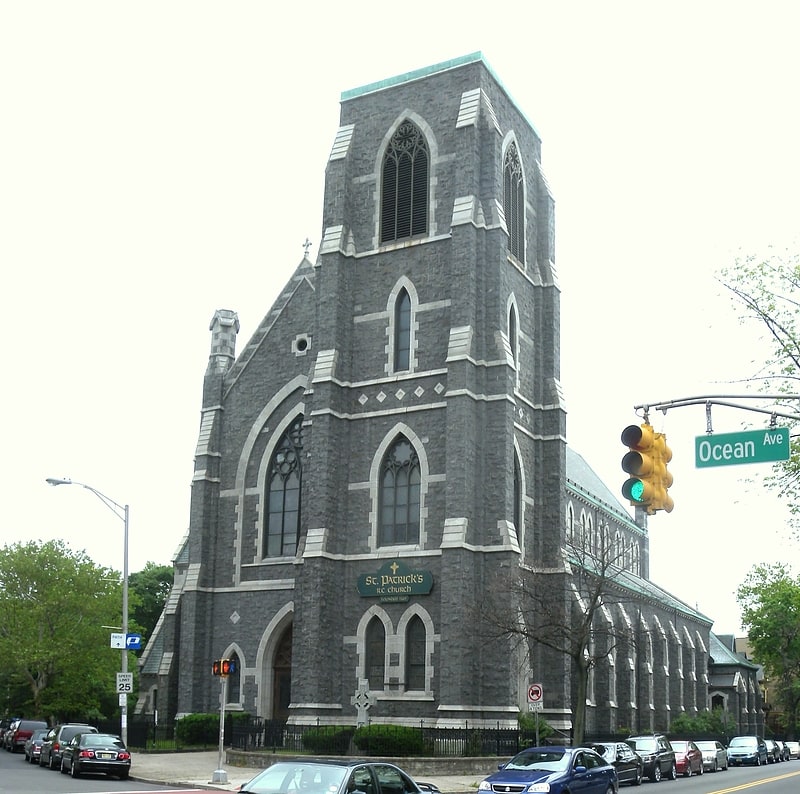
Building in Jersey City. St. Patrick's Parish and Buildings is a historic church on Grand Street, Ocean and Bramhall Avenues in Jersey City, Hudson County, New Jersey, United States. It was built in 1868 and added to the National Register of Historic Places in 1980. The stained glass windows in the church were destroyed in the Black Tom explosion of 1916.
The church appears in the HBO crime drama The Sopranos four times, standing in for a church in Newark in the pilot, season three's Another Toothpick, season four's Watching Too Much Television, and season six's The Ride.[28]
Address: 492 Bramhall Ave, Jersey City, NJ 07304, 07304 Jersey City
St. Anthony of Padua Catholic Church
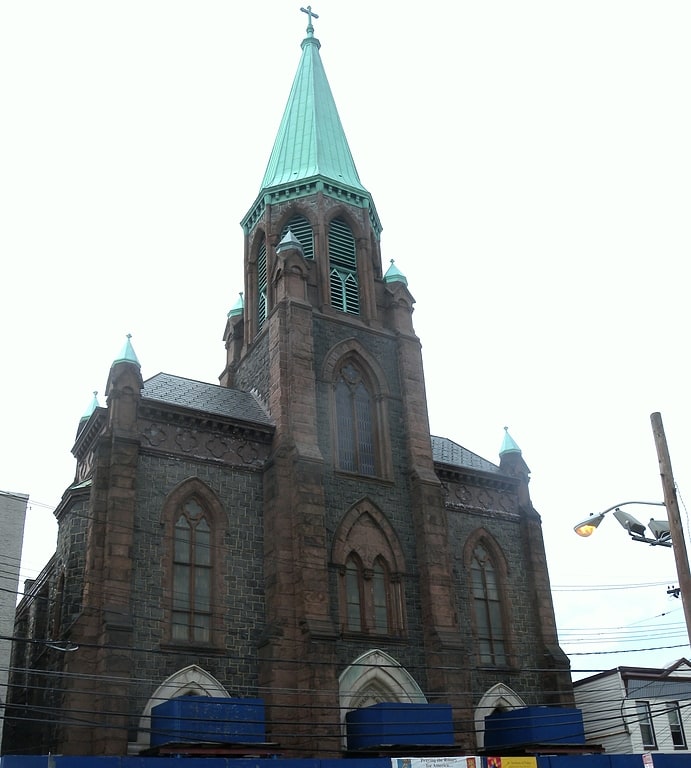
Church in Jersey City, New Jersey. St. Anthony of Padua Catholic Church is a historic Catholic church in The Village section of Jersey City. It is best known for its former school and its boys' basketball program coached by Bob Hurley, Sr.[29]
Address: 457 Monmouth St, 07302 Jersey City
Jersey City Museum
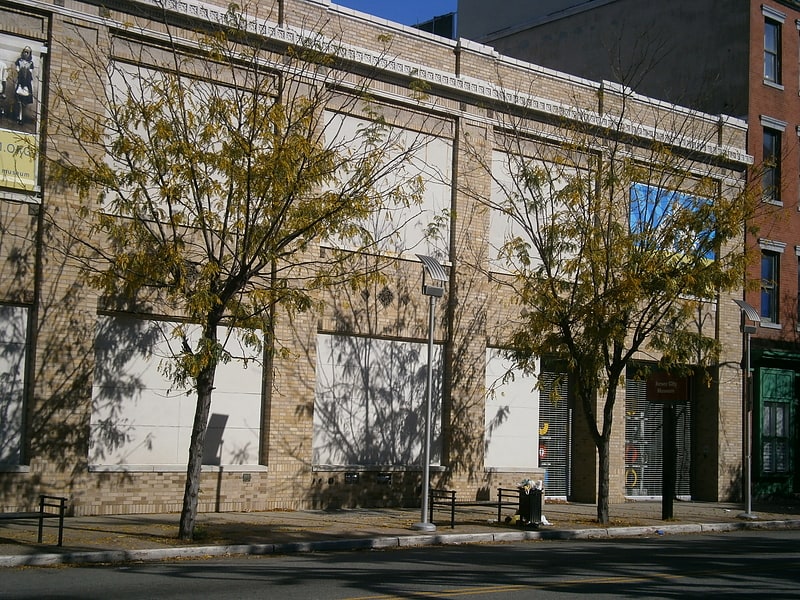
Museum in Jersey City, New Jersey. The Jersey City Museum was a municipal art museum in Jersey City, New Jersey. The museum opened in 1901, and was housed in the main branch of the Jersey City Public Library. It relocated to a new building in 2001, but due to financial difficulties and discord with the city, closed to the public in 2010. In 2018, the museum collection was donated to the Zimmerli Art Museum at Rutgers University.
In 2018, the Jersey City municipal government began the process of establishing a new museum in a historic building at Journal Square. After renovations, it is expected to open in 2024 as Centre Pompidou x Jersey City, a satellite museum of the Centre Pompidou, and exhibit of works of the twentieth and twenty-first centuries from the Pompidou collection.[30]
Address: 350 Montgomery St, 07302 Jersey City
Pershing Field
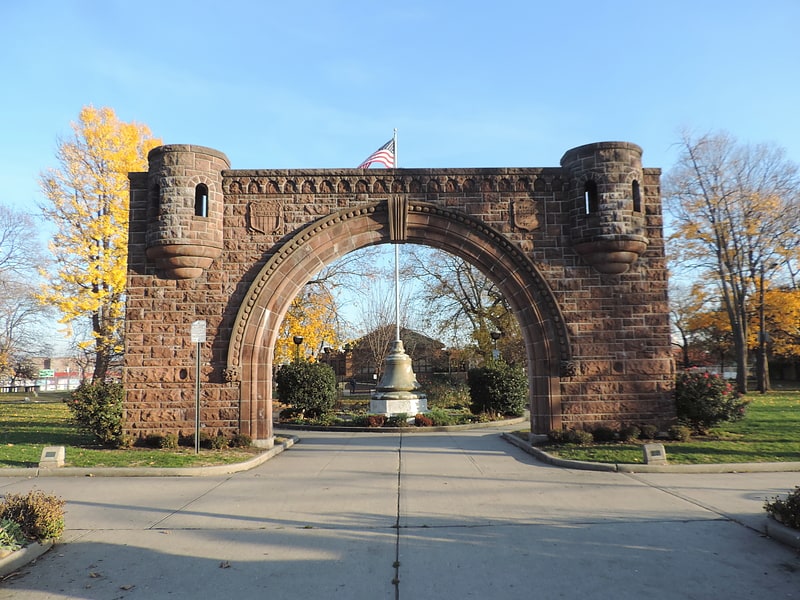
Park in Jersey City, New Jersey. Pershing Field is a city square and park in the Heights of Jersey City, New Jersey in the United States. Approximately 13.5 acres it is adjacent to Jersey City Reservoir No. 3, with which it creates a large open recreational and nature area bounded by Summit Avenue, Central Avenue, and Manhattan Avenue.[31]
Address: Summit Ave, 07307 Jersey City
Lincoln the Mystic
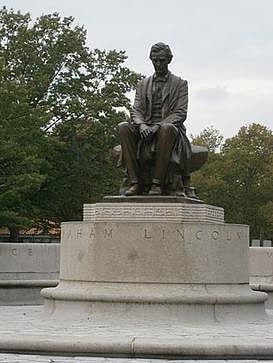
Statue by James Earle Fraser. Lincoln the Mystic, also known as the Abraham Lincoln Memorial, is a bronze statue by James Earle Fraser. It is located at Lincoln Park in Hudson County, New Jersey, near the beginning of the Lincoln Highway.
A full size bronze replica stands in front of the Maxwell School of Citizenship and Public Affairs at Syracuse University.[32]
Liberty Towers
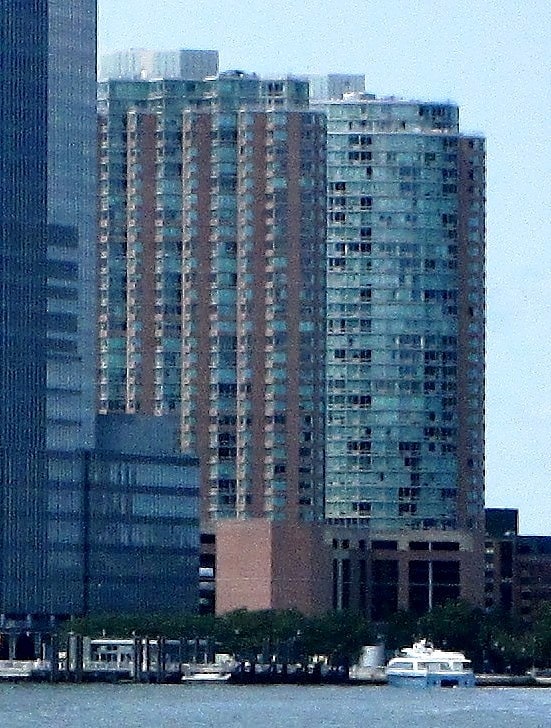
Apartment complex in Jersey City, New Jersey. The Liberty Towers or Liberty View Towers, is an apartment complex in Jersey City, New Jersey. It consists of Liberty Towers West, and Liberty Towers East, both of which were constructed from 2001 to 2003 and have 36 floors. They also have the same height of 380 ft. The buildings rise from the same podium, which is used for parking and also contains a lobby. On top of the podium is a deck with leisure facilities for the tenants. The complex has 648 residential units. They were designed by architect Jordan Gruzen.
The S. A. Wald Company Building was demolished to make way for Liberty Towers, which were originally called "Liberty View Towers". The postmodern buildings are made out of masonry, glass, and concrete.
The building is part of a building boom in Jersey City's decayed railroad, warehouse and waterfront district, which is being redeveloped as large towers complex. It is in the middle of the reconstructed downtown and has access to trains.[33]
Bayview – New York Bay Cemetery
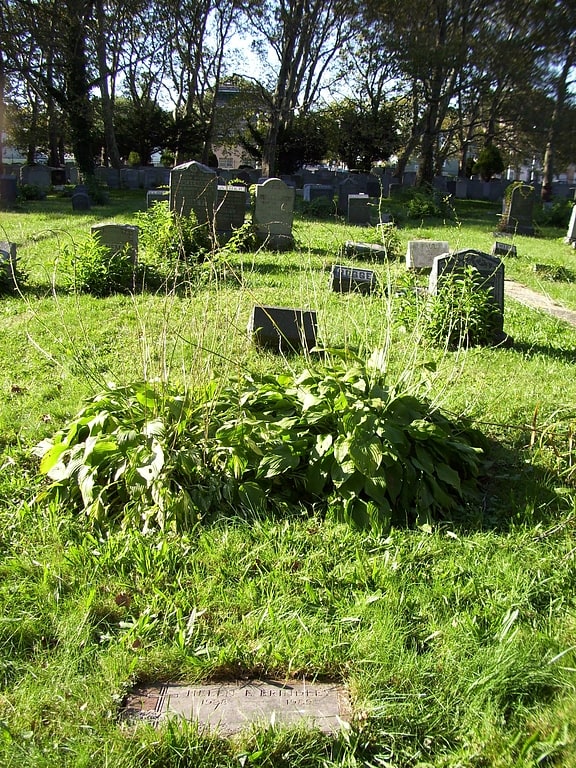
Cemetery in Jersey City, New Jersey. Bayview Cemetery, previously called Greenville Cemetery, is located in Jersey City, New Jersey. It merged with New York Bay Cemetery and is now known as Bayview – New York Bay Cemetery.[34]
Congregation Adas Emuno

Synagogue in Leonia, New Jersey. Congregation Adas Emuno is a Reform synagogue in Leonia, New Jersey.
The congregation was founded in Hoboken, New Jersey.in 1871. They moved into a new synagogue in 1873,and received a donation of a Torah scroll at that time. In 1883 they erected a small new synagogue building, with a mix contains a mix of Gothic and Romanesque styles. That edifice is the oldest synagogue building still standing in New Jersey, though it was subsequently used for some years as a church, and is now a residential building.
In 1971, the congregation moved to Leonia, to a brick building purchased from the Holy Trinity Lutheran Church.
Adas Emuno owns two cemeteries. The older, smaller one is a small section of Hoboken Cemetery (but was originally part of the adjacent Flower Hill Cemetery). The larger, and slightly more recent cemetery is sited in North Arlington, NJ, across Belleville Turnpike from the Arlington Memorial Park. Adas Emuno may have been the first organization to use that cemetery, though many Jewish organizations opened additional sections within it afterwards. While the main gate for the cemetery shows Hebrew year 5669 (generally corresponding to 1909), there are gravestones dating as early as 1899 within the section.[35]
Address: 254 Broad Ave, 07605-1851 Leonia